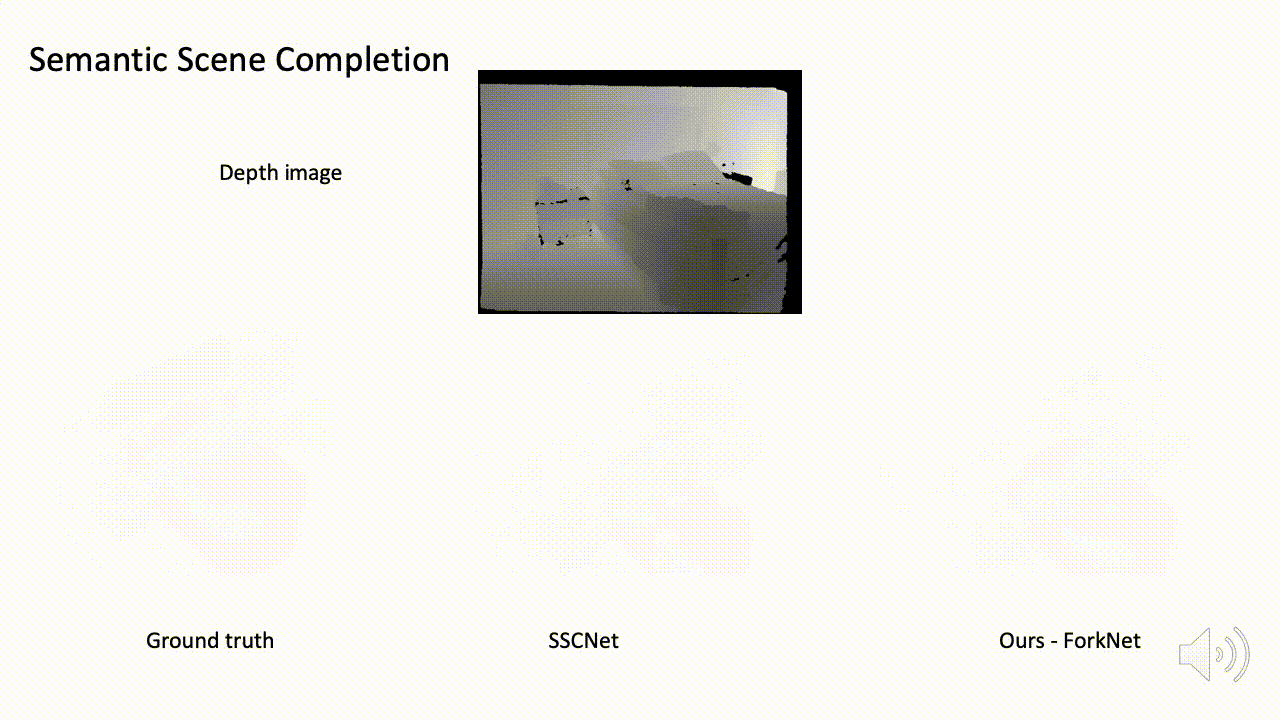ForkNet: Multi-branch Volumetric Semantic Completion from a Single Depth Image
The implementation of our paper accepted in ICCV 2019 (International Conference on Computer Vision, IEEE) Yida Wang, David Tan, Nassir Navab and Federico Tombari. If you find this work useful in yourr research, please cite:
@inproceedings{wang2019forknet,
title={ForkNet: Multi-branch Volumetric Semantic Completion from a Single Depth Image},
author={Wang, Yida and Tan, David Joseph and Navab, Nassir and Tombari, Federico},
booktitle={Proceedings of the IEEE International Conference on Computer Vision},
pages={8608--8617},
year={2019}
}ForkNet
Architecture
The overall architecture is combined with 1 encoder with input of a TSDF volume and 3 decoders.

Generated synthetic samples
Given 1 latent sample, we can use 2 decoders to generate a pair of TSDF volume and semantic scene separately.

More examples
Data preprocessing
Depth image to TSDF volumes
Firstly you need to go to depth-tsdf folder to compile the our depth converter. Then camake and make are suggested tools to compile our codes.
cmake . # configure
make # compiles demo executableAfter the file named with back-project is compiled, depth images of NYU or SUNCG datasets could be converted into TSDF volumes parallelly.
CUDA_VISIBLE_DEVICES=0 python2 data/depth_backproject.py -s /media/wangyida/SSD2T/database/SUNCG_Yida/train/depth_real_png -tv /media/wangyida/HDD/database/SUNCG_Yida/train/depth_tsdf_camera_npy -tp /media/wangyida/HDD/database/SUNCG_Yida/train/depth_tsdf_pcdSemantic volumes used for training
We further convert the binary files from SUNCG and NYU datasets into numpy arrays in dimension of [80, 48, 80] with 12 semantic channels. Those voxel data are used as training ground truth. Notice that our data is presented in numpy array format which is converted from the original binary data
python2 data/depthbin2npy.py -s /media/wangyida/HDD/database/SUNCGtrain_1001_2000 -tv /media/wangyida/HDD/database/SUNCG_Yida/train/voxel_semantic_npy &
python2 data/depthbin2npy.py -s /media/wangyida/HDD/database/SUNCGtrain_501_1000 -tv /media/wangyida/HDD/database/SUNCG_Yida/train/voxel_semantic_npy &
python2 data/depthbin2npy.py -s /media/wangyida/HDD/database/SUNCGtrain_1_1000 -tv /media/wangyida/HDD/database/SUNCG_Yida/train/voxel_semantic_npy &
python2 data/depthbin2npy.py -s /media/wangyida/HDD/database/SUNCGtrain_1001_3000 -tv /media/wangyida/HDD/database/SUNCG_Yida/train/voxel_semantic_npy &
python2 data/depthbin2npy.py -s /media/wangyida/HDD/database/SUNCGtrain_3001_5000 -tv /media/wangyida/HDD/database/SUNCG_Yida/train/voxel_semantic_npy &
python2 data/depthbin2npy.py -s /media/wangyida/HDD/database/SUNCGtrain_1_500 -tv /media/wangyida/HDD/database/SUNCG_Yida/train/voxel_semantic_npy &
python2 data/depthbin2npy.py -s /media/wangyida/HDD/database/SUNCGtrain_5001_7000 -tv /media/wangyida/HDD/database/SUNCG_Yida/train/voxel_semantic_npy &
python2 data/depthbin2npy.py -s /media/wangyida/HDD/database/depthbin_NYU_SUNCG/SUNCGtest_49700_49884 -tv /media/wangyida/HDD/database/SUNCG_Yida/test/voxel_semantic_npy &
python2 data/depthbin2npy.py -s /media/wangyida/HDD/database/depthbin_NYU_SUNCG/NYUtrain -tv /media/wangyida/HDD/database/NYU_Yida/train/voxel_semantic_npy &
python2 data/depthbin2npy.py -s /media/wangyida/HDD/database/depthbin_NYU_SUNCG/NYUtest -tv /media/wangyida/HDD/database/NYU_Yida/test/voxel_semantic_npy &
waitTrain and Test
Training
CUDA_VISIBLE_DEVICES=0 python3 main.py --mode train --discriminative TrueTesting
We provide a compact version of ForkNet which is only 25 MB in the pretrained_model folder If the model is not discriminative
CUDA_VISIBLE_DEVICES=1 python main.py --mode evaluate_recons --conf_epoch 0Otherwise
CUDA_VISIBLE_DEVICES=1 python main.py --mode evaluate_recons --conf_epoch 30 --discriminative Truewhere '--conf_epoch' indicates the index of the pretrained model


